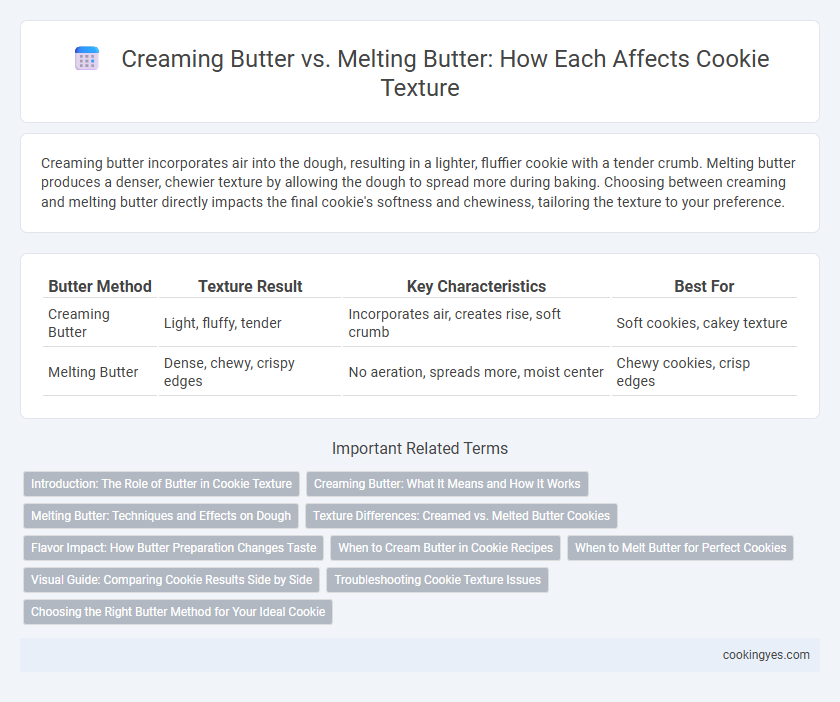Creaming butter incorporates air into the dough, resulting in a lighter, fluffier cookie with a tender crumb. Melting butter produces a denser, chewier texture by allowing the dough to spread more during baking. Choosing between creaming and melting butter directly impacts the final cookie's softness and chewiness, tailoring the texture to your preference.
Table of Comparison
| Butter Method | Texture Result | Key Characteristics | Best For |
|---|---|---|---|
| Creaming Butter | Light, fluffy, tender | Incorporates air, creates rise, soft crumb | Soft cookies, cakey texture |
| Melting Butter | Dense, chewy, crispy edges | No aeration, spreads more, moist center | Chewy cookies, crisp edges |
Introduction: The Role of Butter in Cookie Texture
Butter significantly influences cookie texture by affecting moisture, fat distribution, and air incorporation. Creaming butter traps air, resulting in a lighter, fluffier cookie with a tender crumb. Melting butter produces a denser, chewier cookie due to reduced air content and altered fat crystallization.
Creaming Butter: What It Means and How It Works
Creaming butter involves beating softened butter with sugar until it becomes light and fluffy, creating tiny air pockets that help leaven the cookie dough and produce a tender, airy texture. This method enhances the cookie's structure by allowing the dough to trap gases released during baking, resulting in a soft and chewy bite. Properly creamed butter ensures even distribution of fat and sugar, contributing to an optimal balance of moisture and crumb in the final cookie.
Melting Butter: Techniques and Effects on Dough
Melting butter for cookie dough results in a denser, chewier texture due to the fat integrating more thoroughly with the sugar and flour. Techniques such as gently heating butter until fully liquefied and slightly cooling before mixing prevent overcooking of eggs and ensure even distribution. This method produces cookies with a tender crumb and enhanced flavor, particularly in recipes seeking a fudgier bite rather than a cakey structure.
Texture Differences: Creamed vs. Melted Butter Cookies
Creaming butter incorporates air into the dough, producing cookies with a light, fluffy, and tender crumb, while melted butter results in denser, chewier cookies due to the absence of aeration. Creamed butter cookies tend to spread less and hold their shape better, creating a more structured texture compared to the flatter, crisper edges typical of melted butter cookies. The choice between creaming and melting butter directly influences the cookie's overall mouthfeel and bite, making texture control essential in recipe outcomes.
Flavor Impact: How Butter Preparation Changes Taste
Creaming butter introduces air into the dough, resulting in a fluffier texture and enhanced buttery flavor that deepens the cookie's richness. Melting butter creates a denser cookie with a chewier texture while concentrating the butter's natural flavors for a more pronounced, caramel-like taste. The choice between creaming and melting butter significantly influences both the cookie's texture and the intensity of its buttery flavor profile.
When to Cream Butter in Cookie Recipes
Creaming butter in cookie recipes is essential when aiming for a light, airy texture with defined edges and a tender crumb, as it incorporates air that helps cookies rise and become fluffy. This technique is best used with recipes requiring a soft dough that maintains volume during baking, such as sugar cookies or chocolate chip cookies. Melting butter suits recipes where a denser, chewier texture is desired, like brownies or certain types of drop cookies.
When to Melt Butter for Perfect Cookies
Melting butter is ideal when a chewy and denser cookie texture is desired, as it promotes more spread and moisture retention during baking. Use melted butter in recipes that specify a soft, fudgy consistency or when incorporating ingredients like brown sugar that benefit from enhanced moisture. Melting butter before mixing also aids in evenly distributing flavors and creating a uniform cookie crumb structure.
Visual Guide: Comparing Cookie Results Side by Side
Creaming butter incorporates air into the dough, producing cookies with a lighter, fluffier texture and a golden-brown color, while melting butter results in denser, chewier cookies with a more uniform color. Visual comparison reveals that creamed butter cookies have a taller rise and a crumbly surface, whereas melted butter cookies spread more and exhibit a glossy, smooth appearance. Observing side-by-side images highlights how butter temperature directly influences cookie structure and mouthfeel.
Troubleshooting Cookie Texture Issues
Creaming butter incorporates air, producing fluffy, light cookies with a tender crumb, while melting butter yields denser, chewier textures by promoting gluten development. When cookies spread too much or turn out flat, switching from melted to creamed butter can improve structure and prevent excessive spreading. Adjusting butter texture addresses common cookie issues such as hardness or sogginess, optimizing the final product's chewiness and overall mouthfeel.
Choosing the Right Butter Method for Your Ideal Cookie
Choosing the right butter method directly impacts cookie texture, as creaming butter incorporates air for a lighter, fluffier cookie, while melting butter produces denser, chewier results. Creaming involves beating softened butter with sugar to create a creamy mixture that traps air, ideal for soft, cakey cookies. Melting butter, by contrast, yields a more concentrated fat distribution, enhancing spread and chewiness in cookies like chocolate chip or oatmeal varieties.
Creaming butter vs Melting butter for cookie texture Infographic

 cookingyes.com
cookingyes.com